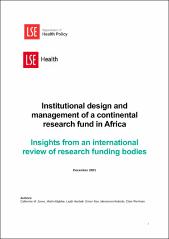Institutional Design and Management of a Continental Research Fund in Africa: Insights from an International Review of Research Funding Bodies
| dc.contributor.author | Kay, Simon | |
| dc.contributor.author | Jones, Catherine M. | |
| dc.contributor.author | Eigbike, Martin | |
| dc.contributor.author | Hanbali, Layth | |
| dc.contributor.author | Kebede, Meskerem | |
| dc.contributor.author | Wenham, Clare | |
| dc.date.accessioned | 2023-09-01T08:57:43Z | |
| dc.date.available | 2023-09-01T08:57:43Z | |
| dc.date.issued | 2021-12 | |
| dc.identifier.uri | http://10.176.203.77/handle/123456789/293 | |
| dc.description.abstract | Funding and delivery mechanisms for research and innovation are vital to developing sustainable research capacity that is necessary for knowledge economies and economic development. African states fund research and innovation through a mix of national research funds or councils (e.g., Burkina Faso, Cote d’Ivoire, Kenya, Mozambique, South Africa, Zimbabwe); innovation funds (e.g., Botswana, Kenya); national science and technology councils (e.g., Malawi, Rwanda, Tanzania, Uganda, Zambia); or through Ministries of Higher Education and/or Scientific Research. Yet, few African governments have met the African Union’s target for spending 1% of GDP on research and development [1]. Wenham and colleagues’ mapping of available data based on 2017/2018 (or latest year available) found that Botswana, Egypt, Ethiopia, Gabon, Kenya, Morocco, Senegal, South Africa, Tanzania, and Tunisia are spending between 0.5 and 0.8% of GDP on research and development [1]. | en_US |
| dc.language.iso | en_US | en_US |
| dc.publisher | APHRC | en_US |
| dc.subject | Research and Related Capacity Strengthening | en_US |
| dc.subject | Research Ecosystem | en_US |
| dc.subject | Research Funding | en_US |
| dc.subject | Research Funding Organisation | en_US |
| dc.subject | African Research Initiative for Scientific Excellence | en_US |
| dc.title | Institutional Design and Management of a Continental Research Fund in Africa: Insights from an International Review of Research Funding Bodies | en_US |
| dc.type | Technical Report | en_US |
Files in this item
This item appears in the following Collection(s)
-
2022 [12]

